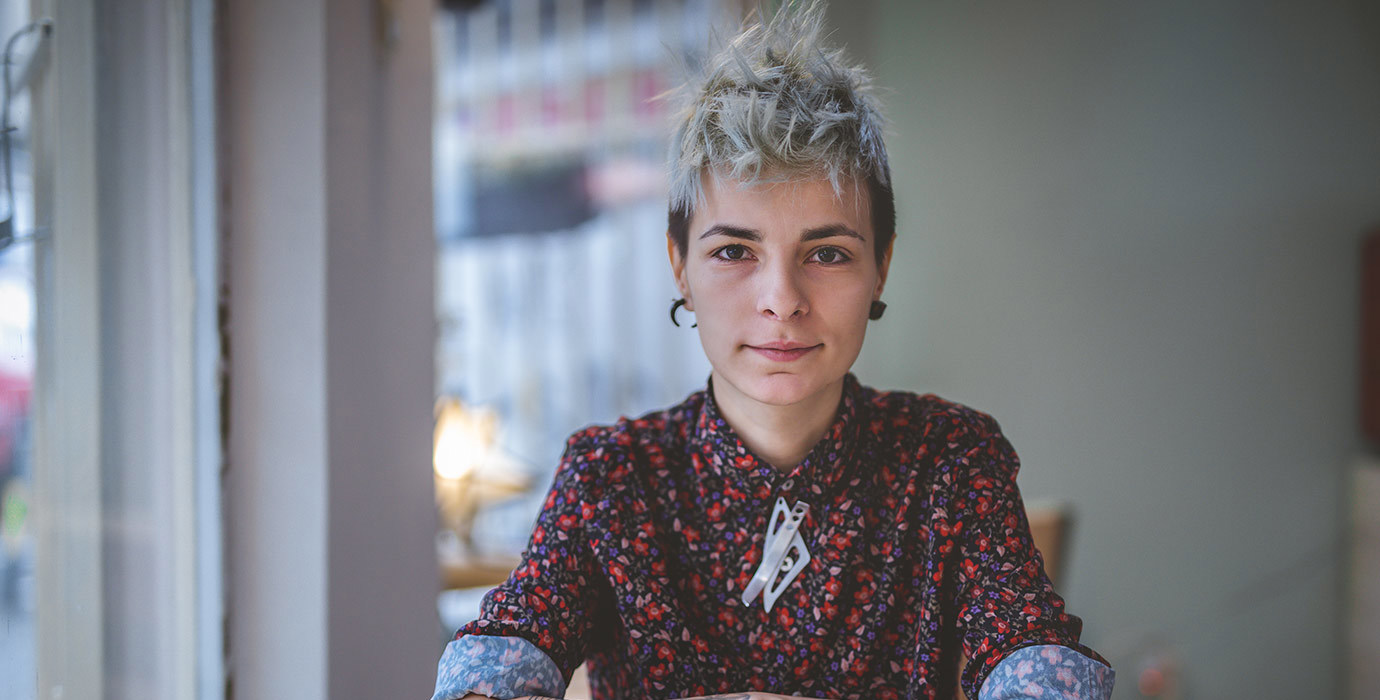
If you are new to counselling LGBTQ2S+ clients, start by assessing your offices and practices to find ways to make your clients feel comfortable and respected.
Creating welcoming offices and websites
What do I wish I’d known when I first started working with sexual and gender minorities?—“I wish [I’d] known to just trust the process. That people are people and that I can be comfortable being myself and using my skills... I have found that taking part in workshops to gain more information on working with [LGBTQ2S+ clients] has been really helpful. Becoming aware of my values and beliefs has been an important part of feeling comfortable. When we work with clients in a holistic manner, many of the counselling skills we use are the same regardless of the issues that clients bring.”
Here are some ways to provide a welcoming environment for LGBTQ2S+ clients:
- Display a small rainbow flag, an internationally recognized symbol of the LGBTQ2S+ movement.
- Display and house artwork, pamphlets, and books that is affirmative of LGBTQ2S+ people.
- Use inclusive language in all printed and online materials, such as intake forms.
- Use inclusive language in oral discussions and presentations. Do not assume heterosexual or cisgender norms.
- Include a section on your website with links to sites that address career development in a sexual and gender minority context.
- Include your preferred pronouns on business cards, email signatures, and social media. Ask your clients about their preferred pronouns and practice using them.
- Model the same language and terms that clients use to identify themselves.
- Be familiar with LGBTQ2S+ career resources and referrals.
Once you have taken these other steps, you may want to display an inverted pink triangle enclosed in a ring of green. This is used in schools and workplaces to help identify safe and allied spaces for LGBTQ2S+ people.
Creating inclusive services
Being respectful—“Counsellors working with sexual [and gender] minorities must have an attitude that [LGBTQ2S+ clients] are not less than; they truly cannot believe that these clients are less than any other person. Counsellors should ask themselves, ‘If my son or daughter turned out to be gay, lesbian, bisexual, or transgender, would I see them as less than anyone else?’”
Here are ways to offer inclusive services to LGBTQ2S+ clients:
- Develop partnerships with LGBTQ2S+ groups in the community.
- Be cautious in your use of career assessments. Be aware that many assessments take a normative or binary approach to gender.
- Offer information sessions and panel discussions that include LGBTQ2S+ persons as guest speakers.
- Familiarize yourself with human rights law and discrimination issues faced by different groups within the LGBTQ2S+ community.
- Host professional development sessions to encourage and discuss the understanding of belonging to sexual and gender minorities.
- Create and offer opportunities to examine attitudes and beliefs and how these might affect counselling interactions with LGBTQ2S+ clients.
- Provide books, articles, and other resources about LGBTQ2S+ issues.
- When working with LGBTQ2S+ clients, trust their stories of discrimination, rather than questioning them.
- Keep track of local employers who define and demonstrate best practices to support LGBTQ2S+ employees and job seekers.
Multicultural counselling approach
One approach to career counselling for sexual and gender minorities is to apply the concepts of multicultural counselling. The reason is that LGBTQ2S+ clients are a minority in our dominant heterosexual, cisgender population.
In this approach, counsellors must be competent in 3 dimensions: self-awareness, knowledge of other world views, and counselling skills.
Self-awareness
Culturally aware counsellors focus on their own belief systems by:
- Examining their own assumptions on human behaviour, values, biases, preconceived notions, and personal limitations
- Becoming aware of how sexual and gender minorities fit into their own world views
- Understanding how their own cultural experiences relate to their beliefs and attitudes about LGBTQ2S+ people
- Examining how their own world views impact their interactions with LGBTQ2S+ clients
Be aware that your cultural background may, at times, result in your beliefs and world views contrasting with those of your clients. Professional reflection about personal culture helps to develop self-awareness. This is a core competency in the domain of multicultural counselling.
Attitudes and knowledge—“If counsellors have the attitudes (accepting, non-judgmental, open) and the knowledge about sexual [and gender] minorities, that is the main thing.”
You may wish to reflect on these questions:
- Would you use the services of a physician or dentist who was openly LGBTQ2S+?
- How would you feel if your son or daughter became explicitly out?
- How would you feel about sharing a hotel room with a LGBTQ2S+ person of your gender?
- Would you allow yourself to become close friends with someone who is LGBTQ2S+?
- Would you invite open LGBTQ2S+ people to your wedding and encourage them to dance with their same-sex partners?
- Do you believe that LGBTQ2S+ people are equal to heterosexual and cisgender people in every respect?
- If you were (or are) LGBTQ2S+, how open would you (or do you) feel about it where you live and where you work?
If you feel hesitant or reluctant to answer these questions, you have some work to do before you are ready to work with LGBTQ2S+ clients. By necessity, members of the LGBTQ2S+ community are closely attuned to how others perceive them. Even when those perceptions are hidden and communicated very subtly, members of sexual and gender minorities are very good at sensing them. They may adjust their openness, behaviour, and level of trust accordingly.
Knowledge of other world views
The importance of knowing about LGBTQ2S+ culture—“Living in communities that routinely discriminate against gay men and lesbian women makes it difficult if not virtually impossible to avoid internalizing negative stereotypes or attitudes about this sexual minority culture. Because misinformation or misunderstanding will quickly be evident to sexual minority clients, and may cause them to seek help elsewhere or not to get help at all, counsellors must be familiar with [LGBTQ2S+] culture so they are credible and congruent in their attitudes.”
There is evidence of heterosexist or cissexist biases in counselling practices with persons belonging to sexual and gender minorities. Some of this bias is a result of lack of information about LGBTQ2S+ clients and their issues, lifestyles, and resources.
Culturally aware counsellors may broaden their knowledge of LGBTQ2S+ clients by:
- Trying to understand their world view without making negative judgments
- Talking to career counsellors who identify as LGBTQ2S+ or are experienced with LGBTQ2S+ clients
- Attending workshops or training events
- Seeking out resources in the community
- Reading books, journal articles, and websites
Counselling skills
Teaching others to have an open heart—“Counsellors with an ‘open heart’ can be instrumental not only in helping these individuals, but also in teaching others about them and the issues that they face.”
Culturally aware counsellors seek to build skills by:
- Practising appropriate, relevant, and sensitive intervention strategies and skills
- Acknowledging the cultural values and life experiences of clients
- Incorporating the values of clients into the counselling process, as appropriate
The affirmative social justice approach
The affirmative model is grounded in intake and assessment processes that affirm gender and sexual diversity from the outset, up front. It then applies a social justice approach, which recognizes that all clients come with multiple, intersecting identities. These include gender and sexual identities. But they also extend out to other personal, professional, and cultural identities that the client consciously or subconsciously identifies with.
Each client has a unique balance of these possible identities. The combined impact that social structures have on each of those identities causes the client to occupy a definable location within society. This intersection of identities and resulting social location influence and shape an individual’s career.
In a social justice approach, counsellors engage at a systemic level and act as advocates within society. As a career counsellor, you can be an advocate in your own profession to create environments and practices that are more welcoming and affirmative for LGBTQ2S+ clients. Create, support, and promote local job fairs dedicated to LGBTQ2S+ job seekers, and use those to raise broader awareness of related workplace issues. Work to educate employers, share best practices for the workplace, and support the development of safe spaces for diverse LGBTQ2S+ clients in local labour markets.
Other counselling approaches and concerns
You may want to consider professional ethics, successful counselling strategies, referrals, and special issues of different groups within the LGBTQ2S+ community.
Professional ethics
Professional counselling associations identify equal treatment for all clients as ethically correct for their members. However, many counsellors continue to show subtle or more obvious signs of discrimination against LGBTQ2S+ clients. Such discrimination may take the form of avoiding topics that are uncomfortable for the counsellor, minimizing the importance of issues related to sexual orientation and gender identity, and so on.
Successful strategies
These counselling tips come from practitioners who work with LGBTQ2S+ clients:
- Reflect on your own experiences with LGBTQ2S+ persons and try to understand more of their experiences. For example, become familiar with the gender transitioning experience or imagine what it would feel like to be rejected by friends, families, or co-workers upon coming out.
- Consider these questions: What are the LGBTQ2S+ clients like? What is their experience? How are they dealt with?
- Examine your own beliefs and values. Reflect on how they may affect your work with LGBTQ2S+ persons.
- Accept that you may not have all the answers, and let clients know that.
- Review confidentiality policies. Reassure clients that your counselling conversation is between you and them. Building trust is key.
- Explore clients’ support systems. Many LGBTQ2S+ clients live in isolation. They may not have support from families or friends.
- Be inclusive in speech. Be sensitive to the use of terms such as husband or wife, or pronouns such as he or she.
- Be sensitive to terminology that is or is not used in the LGBTQ2S+ community. Some lesbian women may take offence at being called gay. Avoid terms historically targeted for discrimination such as homosexual or transsexual.
- Be sensitive to clients who may be at different stages of their sexual or gender identity formation.
- Don’t make generalizations about the LGBTQ2S+ population, which is extremely diverse. Remember that what LGBTQ2S+ clients tell you is about them and not about all LGBTQ2S+ persons.
Referrals to other counsellors
Counsellors are employees under the Alberta Human Rights Act. All counsellors have the right to work in a respectful, inclusive work environment free of discrimination. You are responsible for treating clients, co-workers, and the public with respect and dignity. You must make sure that you do not participate in discriminatory conduct based on a protected ground, such as sexual orientation, gender identity, or gender expression.
Be sure that you have a clear understanding of your own personal and professional boundaries and how those may intersect with the Act:
- If you don’t have expertise with the LGBTQ2S+ community, refer clients who are actively exploring their sexual orientation or gender identity to other counsellors who do. It is important not to minimize the issue.
- If you have beliefs and values that might conflict with working with LGBTQ2S+ clients, it is important to refer the clients to an appropriate counsellor.
- Reassure clients whom you are referring to other counsellors. Explain that the reason that you are referring them is to make certain they get help from someone who is best able to support them.
- Explain to the client what to expect from the referral.
- Follow up with the client. If necessary, find more sources of support.
Testing biases
Evaluate any testing instruments you are considering for use with clients belonging to sexual or gender minorities. The literature on using career assessment instruments with LGBTQ2S+ clients agrees that the results of tests may not be as reliable or valid.
Bisexual clients
A cause of stress in bisexual clients is the polarization of sexual orientation into heterosexual and homosexual categories. Because of the polarization, some people assume that these clients are in a transitional stage of development and must be guided to choose a dominant preference.
The Society for Safe and Caring Schools & Communities advises that “contemporary research refutes the notion of sexuality as a binary choice. Counsellors are encouraged to adopt a more complex understanding of sexuality that sees physical, emotional and erotic attractions as fluid, relational and situated.”
Cultural minorities
When working with LGBTQ2S+ clients who are also members of ethnic, cultural, or religious minorities, consider these factors:
- The importance of family, community, and religious connections.
- The degree to which the client believes in North American values on sexuality, sexual orientation, and gender identity.
- The client’s history of discrimination or oppression.
- The local community’s beliefs about gender expression or same-sex relationships.
- Different attitudes toward disclosing sexual orientation and gender identity. For example, non-disclosure does not necessarily indicate shame, denial, or lack of pride in one’s sexual or gender identity.
Helping LGBTQ2S+ clients with career strategies
The importance of sexual and gender identity—“When you believe it’s possible to achieve professional success based on your personal identity, you acknowledge that you are worthy of success. Who we are as human beings is the most important career asset we possess and sexual orientation is part of our identity.”
There is a relationship between the stage of sexual or gender identity development and the career development process. It is difficult for clients to focus on career-related matters when they are preoccupied with deeper identity issues. As a result, career development for these individuals can be delayed.
Clients’ values and beliefs
People’s values and beliefs have a major impact on their occupational choices. This factor is particularly significant for clients who belong to sexual and gender minorities. The experience of discrimination, both past and anticipated, may also be a factor in considering various occupational sectors. You have an important role to play in helping clients explore their values and beliefs.
The following activities may help clarify a client’s personal beliefs about gender, sexuality, and related stereotypes:
- Try a guided self-exploration process to identify what is important in their work and non-work roles.
- Write narratives to explore values.
- Answer open questions about what values are most important.
- Prepare lifelines, life stories, future autobiographies, and guided fantasies to look toward and compare possible futures.
In general, try to help clients explore their preferred future and related work roles. Make sure they identify and build on their strengths rather than limiting their choices with past stereotypes.
Occupational choices
In some occupational areas, choices are influenced by past prejudice. For example, some LGBTQ2S+ persons may wrongfully think that working with children will not be considered socially acceptable. As well, because of the community’s history of persecution, clients may be averse to careers in law enforcement or the armed forces. They often view work in tourism, creative fields, and helping professions as safer and more accommodating.
In general, people choose careers in which they can express their identity and take a comfortable level of risk, while making use of their skills and abilities. In the case of LGTQ2 clients, the question of identity is simply more nuanced and important, while risk expands to include matters of discrimination and personal safety.
Role models and mentors
LGBTQ2S+clients may benefit from connecting with other members from the community who are willing to act as mentors and role models. LGBTQ2S+ mentors can offer occupational or lifestyle information about their experiences. You can help establish mentorships by actively seeking out such role models for persons belonging to sexual and gender minorities. Local LGBTQ2S+ organizations will be a valuable resource.
The increasing numbers of public figures who are out provide outstanding role models. There are many examples of prominent individuals in politics, business, culture, and sports. Respected LGBTQ2S+ figures include Olympic athletes, members of Parliament, business leaders, and award-winning artists and entertainers. Consider sharing potentially meaningful role models with LGBTQ2S+ clients.


